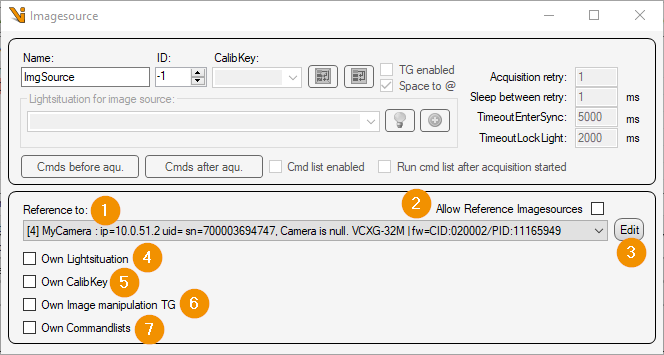Image Source Organization¶
Global, Job or ToolGroup Item?¶
Image sources are organized in Image Source Lists at different hierarchical levels: ToolGroup Items and Jobs have their own Image Source Lists. In addition, there is an overarching global-image-sources-list.
For image acquisition, the image source list of the ToolGroup Item is always used. This can either directly contain the actual image source, e.g. a camera, or access image sources from other lists via so-called reference-image-sources.
Hint
If the same camera with the same parameters is used in several ToolGroup items, reference image sources should always be used, as the parameters can then be changed centrally in one place.
Editing of the image source list at ToolGroupItem level is done in the ToolGroup Item Editor, that of the job in the Job Editor. Job image sources should be used when a job has multiple ToolGroup Items with the same image sources and they are only needed within the job.
The global image source list can be configured via the main-menu. It is particularly used when the same image sources are accessed from multiple jobs. The global image source list is loaded and managed by the BV type. The name global comes from the fact that the image sources of all BV types are loaded from the same file. Thus, all BV types use the same image sources. For special applications this path is also per type configurable.
Note
To speed up the change to another BV type, the connections to the global cameras are not closed until the new type is loaded and uses different cameras than the previous one.
How image sources are most appropriately split varies by application. In order to be able to easily change the division afterwards, the image source lists support many editing-options.
Reference image sources¶
Reference image sources are parameterless references to other image sources. The reference target must be referencable by a defined ID. During image acquisition, the parameters of the referenced image source are used, as long as they are not overwritten. Overwriting parameters is only possible for accompanying parameters, such as the lighting situation, but not for camera parameters themselves.
Reference image sources are created like all others in the Image Source Lists and configured via Image Source Editor:

Reference to: Display and selection of an image source as reference target. Only image sources with a defined ID can be selected.
Allow Reference Imagesources: If this option is active, reference image sources can also be selected as reference targets. The user must then avoid ring references.
Edit: Opens the Image Source Editor of the selected reference.
Own Lightsituation: If active, the custom setting within the reference image source is used instead of the light-situation of the reference.
Own CalibKey: If active, the custom setting within the reference image source is used instead of the calib key of the reference.
Own Image manipulation TG: If active, the custom setting within the reference image source is used instead of the manipulation-toolgroup of the reference.
Own Commandlists: If active, the custom setting within the reference image source is used instead of the Commandos of the reference.
Note
References to reference image sources may be required if Image Source Selectors is used to switch between reference image sources.
Hint
The definition of the referenced sources should preferably be done centrally, for example in the global list.